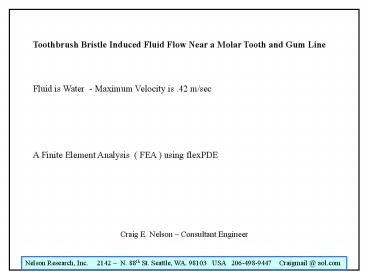Flow Near a Molar - PowerPoint PPT Presentation
Title:
Flow Near a Molar
Description:
A Finite Element Analysis ( FEA ) using flexPDE. Nelson Research, Inc. ... (note that the dynamic viscosity for air is only 50 x less than water! ... – PowerPoint PPT presentation
Number of Views:37
Avg rating:3.0/5.0
Title: Flow Near a Molar
1
Toothbrush Bristle Induced Fluid Flow Near a
Molar Tooth and Gum Line Fluid is Water -
Maximum Velocity is .42 m/sec A Finite
Element Analysis ( FEA ) using flexPDE
Craig E. Nelson Consultant Engineer
2
Goals for the Numerical Experiment
- Obtain experience modeling fluid dynamic
situations involving toothbrushes, teeth and gums - Learn where physical sensors might be placed in
order to make accurate physical measurements
3
Numerical Experiment Setup
4
Full Mouth is Too Complicated to Efficiently Model
5
A Single Tooth and Gumline Are OK
6
Part of a Tooth and Gum Line is Even Better
Solution Domain
7
Solution Method
8
Solution Space Fluid Physics Equation Set
The incompressible Navier-Stokes vector-form
equation is a nonlinear partial differential
equation of second order as follows with
(Continuity Conservation of Mass) where v is a
vector representing the velocity of an
infinitesimal element of mass at a point in 3-D
space, p is the scalar pressure at the same
point, rho is the mass density at the point and
is assumed constant throughout the medium, mu is
the dynamic viscosity of the medium, and g is a
constant vector acceleration due to some constant
external force on the infinitesimal element,
usually taken to be gravity. I used FlexPDE, a
general purpose partial differential equation
solving software engine, with appropriate
boundary conditions, to solve the equation set.
9
Regarding Viscous Shear Forces
Dynamic (absolute) Viscosity is the tangential
force per unit area required to move one
horizontal plane with respect to the other at
unit velocity when maintained a unit distance
apart by the fluid. The shearing stress between
the layers of non turbulent fluid moving in
straight parallel lines can be defined for a
Newtonian fluid as
10
Shear Force Laws for Non-Newtonian Fluids
Bingham fluids In Bingham fluids, we have
something slightly different
Those are fluids
capable of bearing some shear before they start
flowing. Some common examples are toothpaste and
silly putty. Power-law fluid It is an idealized
fluid for which the shear stress, t, is given by
This form is useful for
approximating all sorts of general fluids.
11
Shear Force Measures and Units
The dynamic or absolute viscosity can be
expressed like t µ dc/dy (1) where t
shearing stress µ dynamic viscosity Equation
(1) is known as the Newtons Law of Friction. In
the SI system the dynamic viscosity units are N
s/m2, Pa s or kg/m s where 1 Pa s 1 N s/m2 1
kg/m s The dynamic viscosity is also often
expressed in the metric CGS (centimeter-gram-secon
d) system as g/cm.s, dyne.s/cm2 or poise (p)
where 1 poise dyne s/cm2 g/cm s 1/10 Pa s
For practical use the Poise is to large and it's
usual divided by 100 into the smaller unit called
the centiPoise (cP) where 1 p 100 cP Water at
68.4oF (20.2oC) has an absolute viscosity of one
- 1 - centiPoise.
12
Fluid Media Defining Parameters Used in the
Numerical Experiment
the dynamic viscosity, has values of, for water
1 10 -3 NewtonSeconds / m2 for air 1.85
10 -5 NewtonSeconds / m2 (note that the
dynamic viscosity for air is only 50 x less than
water!). Density of water is 103
kg/m3 Density of air is 1.25 kg/m3 (note
that the density for air is 800 x less than
water).
Air values are given for illustration water was
the media for this experiment
13
Analysis Domain and Experiment Parameters
All units are MKS
14
Results
15
Velocity X Direction
Painted
Contour
16
Velocity y Direction
Painted
Contour
17
Velocity Magnitude
Painted
Contour
18
Velocity Vector Plot
Entrained Fluid
Low velocity eddy vortex
19
Pressure
Painted
Contour
20
Pressure on Tooth and Gumline
21
Tangential Direction Velocity (Shear) Force
22
X and Y Direction Velocity (Shear) Force
X Direction
Y Direction
23
X and Y Direction Pressure Force
X Direction
Y Direction
24
X and Y Direction Total (Shear Pressure) Force
X Direction
Y Direction
25
Total Force (Shear Pressure) - Tooth and Gumline
26
Summary and Conclusions
- Fluid flow near a tooth and gum line has been
examined by means of a numerical experiment - The numerical experiment shows flow velocities
and pressures that are reasonable to expect when
a power tooth brush is used - Many other interesting and useful numerical
experiments can be performed































